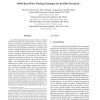58 search results - page 11 / 12 » Detection of New Malicious Code Using N-grams Signatures |
ACSAC
2005
IEEE
15 years 4 months ago
2005
IEEE
Microscopic analysis of malicious code (malware) requires the aid of a variety of powerful tools. Chief among them is a debugger that enables runtime binary analysis at an instruc...
IEEEARES
2009
IEEE
15 years 5 months ago
2009
IEEE
—Targeting the operating system kernel, the core of trust in a system, kernel rootkits are able to compromise the entire system, placing it under malicious control, while eluding...
102
click to vote
VIROLOGY
2010
14 years 9 months ago
2010
Abstract. This paper gives an overview of our research in the automation of the process of software protection analysis. We will focus more particularly on the problem of obfuscati...
CORR
2010
Springer
14 years 11 months ago
2010
Springer
In our previous work (`An Algebraic Watchdog for Wireless Network Coding'), we proposed a new scheme in which nodes can detect malicious behaviors probabilistically, police th...
108
click to vote
SP
2007
IEEE
15 years 5 months ago
2007
IEEE
Law enforcement agencies need the ability to conduct electronic surveillance to combat crime, terrorism, or other malicious activities exploiting the Internet. However, the prolif...

